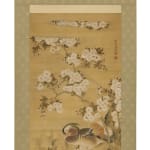Nagasaki School
Pair of Mandarin Ducks, ca 1800
Hanging scroll; ink, mineral colors and shell powder on silk
Overall size 67 x 20½ in. (170 x 52 cm)
Image size 31½ x 15¼ in. (80.3 x 39.1 cm)
Image size 31½ x 15¼ in. (80.3 x 39.1 cm)
T-3652
Further images
-
(View a larger image of thumbnail 1
)

-
(View a larger image of thumbnail 2
)

-
(View a larger image of thumbnail 3
)

-
(View a larger image of thumbnail 4
)

-
(View a larger image of thumbnail 5
)

-
(View a larger image of thumbnail 6
)

-
(View a larger image of thumbnail 7
)

-
(View a larger image of thumbnail 8
)

-
(View a larger image of thumbnail 9
)

Signed at top right Senkashi sha (Drawn by Senkashi) with seal Genshōshi; sealed at lower right Senka A male and a female mandarin duck—in East Asia, perennial symbols of marital...
Signed at top right Senkashi sha (Drawn by Senkashi) with seal Genshōshi; sealed at lower right Senka
A male and a female mandarin duck—in East Asia, perennial symbols of marital fidelity—are shown by a river beneath a flowering cherry tree, the male perched on one of the branches and the female in the water. The birds’ feathers and the flowering branches of cherry overhanging the river are handled with the utmost delicacy, using mineral pigments along with especially fine gofun (powdered shell), so thinly applied as to be transparent in places; a few deft touches in ink indicate the river’s opposite shore.
This accomplished composition is a fine example of a type of Chinese-looking bird-and-flower painting that was widely practiced in Japan during the latter part of the Edo period (1615–1868). Originally introduced to Japan by a Chinese artist, Shen Nanpin (in Japanese, Chin Nanpin), who resided in the port town of Nagasaki in 1731–1733, the style was subsequently reinforced by other visiting Chinese painters. No documentary of Senka or Senkashi has so far been found.
A male and a female mandarin duck—in East Asia, perennial symbols of marital fidelity—are shown by a river beneath a flowering cherry tree, the male perched on one of the branches and the female in the water. The birds’ feathers and the flowering branches of cherry overhanging the river are handled with the utmost delicacy, using mineral pigments along with especially fine gofun (powdered shell), so thinly applied as to be transparent in places; a few deft touches in ink indicate the river’s opposite shore.
This accomplished composition is a fine example of a type of Chinese-looking bird-and-flower painting that was widely practiced in Japan during the latter part of the Edo period (1615–1868). Originally introduced to Japan by a Chinese artist, Shen Nanpin (in Japanese, Chin Nanpin), who resided in the port town of Nagasaki in 1731–1733, the style was subsequently reinforced by other visiting Chinese painters. No documentary of Senka or Senkashi has so far been found.








